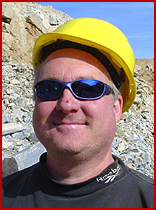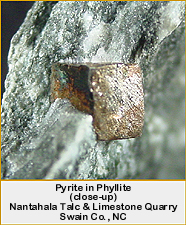As the field trip leader for the Southern Appalachian Mineral Society (SAMS), I arranged a field trip to the
 Nantahala Talc & Limestone Quarry in Swain County. I generally like to conduct at least one field trip per year there, especially during the fall color season when the mornings are generally frosty but the afternoons are still warm - exactly as it turned out on this fine Saturday.
Nantahala Talc & Limestone Quarry in Swain County. I generally like to conduct at least one field trip per year there, especially during the fall color season when the mornings are generally frosty but the afternoons are still warm - exactly as it turned out on this fine Saturday.
Since the large quarry can accommodate an army of rockhounds, I invited numerous other rockhounding clubs to join us. Besides a fine turnout of SAMS members, represented at the quarry that day were members of the Georgia Mineral Society, Western Piedmont Gem & Mineral
 Society, Rome Georgia Mineral Society, and the Knoxville Gem and Mineral Society. Ernie Carter and Madelyn Anderson with the Ozark Earth Science Club won the prize for the farthest traveled. They had contacted me to say that they had planned to use my book to rockhound in western North Carolina during the week prior to the field trip, so I invited them to join our group.
Society, Rome Georgia Mineral Society, and the Knoxville Gem and Mineral Society. Ernie Carter and Madelyn Anderson with the Ozark Earth Science Club won the prize for the farthest traveled. They had contacted me to say that they had planned to use my book to rockhound in western North Carolina during the week prior to the field trip, so I invited them to join our group.
Although the quarry is perhaps best known for its banded pink, gray, green, yellow and tan marble, a wide variety of other rocks and minerals have been identified there, including aragonite, calcite, dolomite, quartz, travertine, talc, pyrite, and limonite after pyrite.

Soon after we arrived, parked and I gave a brief safety talk, everyone headed off in various directions to any of a number of benches in the quarry. While Jeff Deere, Don Henderson, Jim Flora and I took turns whacking away with sledges and chisels on some large boulders
covered in travertine with aragonite and calcite pockets, Chrissy led a contingent to the upper reaches of the quarry to hunt for goodies. As is often the case, her "independent streak" payed off big time as you will see later in this report.
After about an hour of banging away on our boulders, Chrissy hollered down to us from above telling us that we just had to get up there right away because she was finding some killer stuff. "Heard that before only to be unimpressed when I got there", I thought to myself, but I yelled back that I'd be right up. After all, Chrissy has proven time and again that she is quite the excellent "locator" of fine rocks and minerals, although she has occasionally gotten enthused about something that made me have to pretend excitement.
I drove up the steep quarry road, parked and made my way over to where Chrissy and others were banging away in a pile of jagged rocks and boulders. The quarry owner, Jack Herbert, told me blasting had taken place in the week prior to our field trip so there was plenty of new rock to sort through. Chrissy took me on a tour of what had excited her. There were huge boulders covered with thick and banded travertine and lined with unusual crystals and formations of what appeared to be calcite and aragonite on surfaces and within pockets. It soon became apparent that some sort of cave system had been exposed by blasting and the remnants of it were strewn over a large area near the top of the quarry. The following pictures show some of the material that we recovered.
Click on each specimen picture to enlarge











 Nantahala Talc & Limestone Quarry in Swain County. I generally like to conduct at least one field trip per year there, especially during the fall color season when the mornings are generally frosty but the afternoons are still warm - exactly as it turned out on this fine Saturday.
Nantahala Talc & Limestone Quarry in Swain County. I generally like to conduct at least one field trip per year there, especially during the fall color season when the mornings are generally frosty but the afternoons are still warm - exactly as it turned out on this fine Saturday.
 Society, Rome Georgia Mineral Society, and the Knoxville Gem and Mineral Society. Ernie Carter and Madelyn Anderson with the Ozark Earth Science Club won the prize for the farthest traveled. They had contacted me to say that they had planned to use my book to rockhound in western North Carolina during the week prior to the field trip, so I invited them to join our group.
Society, Rome Georgia Mineral Society, and the Knoxville Gem and Mineral Society. Ernie Carter and Madelyn Anderson with the Ozark Earth Science Club won the prize for the farthest traveled. They had contacted me to say that they had planned to use my book to rockhound in western North Carolina during the week prior to the field trip, so I invited them to join our group. 

 their hineys up to where we were. Before long, just about everyone who had come that day had made their way up and over to Chrissy's cave material area
and were happily banging away on rocks and recovering many fine specimens. Jeff was undeterred and seemed almost proud when an errant rock fragment gave his
nose a little more character. Don was like a kid in a candy store as he filled yet another bucket. It is always good to see kids on a dig, as was the case for Wayne Hooper with the Georgia Mineral Society who brought his daughter, Kelsey, along.
their hineys up to where we were. Before long, just about everyone who had come that day had made their way up and over to Chrissy's cave material area
and were happily banging away on rocks and recovering many fine specimens. Jeff was undeterred and seemed almost proud when an errant rock fragment gave his
nose a little more character. Don was like a kid in a candy store as he filled yet another bucket. It is always good to see kids on a dig, as was the case for Wayne Hooper with the Georgia Mineral Society who brought his daughter, Kelsey, along.






